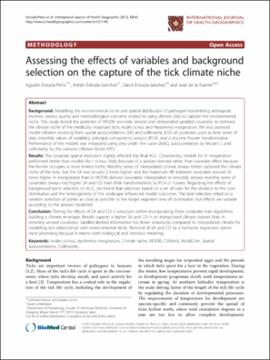| dc.contributor.author | Estrada-Pena, Agustin | |
| dc.contributor.author | Estrada-Sanchez, Adrian | |
| dc.contributor.author | Estrada-Sanchez, David | |
| dc.contributor.author | Fuente, Jose de la | |
| dc.date.accessioned | 2019-09-25T18:24:36Z | |
| dc.date.available | 2019-09-25T18:24:36Z | |
| dc.date.issued | 2013-09-26 | |
| dc.identifier | oksd_estradapena_assessingtheeff_2013 | |
| dc.identifier.citation | Estrada-Pena, A., Estrada-Sanchez, A., Estrada-Sanchez, D., & Fuente, J. d. l. (2013). Assessing the effects of variables and background selection on the capture of the tick climate niche. International Journal of Health Geographics, 12(1). https://doi.org/10.1186/1476-072X-12-43 | |
| dc.identifier.uri | https://hdl.handle.net/11244/321423 | |
| dc.description.abstract | Background: Modelling the environmental niche and spatial distribution of pathogen-transmitting arthropods involves various quality and methodological concerns related to using climate data to capture the environmental niche. This study tested the potential of MODIS remotely sensed and interpolated gridded covariates to estimate the climate niche of the medically important ticks Ixodes ricinus and Hyalomma marginatum. We also assessed model inflation resulting from spatial autocorrelation (SA) and collinearity (CO) of covariates used as time series of data (monthly values of variables), principal components analysis (PCA), and a discrete Fourier transformation. Performance of the models was measured using area under the curve (AUC), autocorrelation by Moran's I, and collinearity by the variance inflation factor (VIF). | |
| dc.description.abstract | Results: The covariate spatial resolution slightly affected the final AUC. Consistently, models for H. marginatum performed better than models for I. ricinus, likely because of a species-derived rather than covariate effect because the former occupies a more limited niche. Monthly series of interpolated climate always better captured the climate niche of the ticks, but the SA was around 2 times higher and the maximum VIF between covariates around 30 times higher in interpolated than in MODIS-derived covariates. Interpolated or remotely sensed monthly series of covariates always had higher SA and CO than their transformations by PCA or Fourier. Regarding the effects of background point selection on AUC, we found that selection based on a set of rules for the distance to the core distribution and the heterogeneity of the landscape influenced model outcomes. The best selection relied on a random selection of points as close as possible to the target organism area of distribution, but effects are variable according to the species modelled. | |
| dc.description.abstract | Conclusion: Testing for effects of SA and CO is necessary before incorporating these covariates into algorithms building a climate envelope. Results support a higher SA and CO in an interpolated climate dataset than in remotely sensed covariates. Satellite-derived information has fewer drawbacks compared to interpolated climate for modelling tick relationships with environmental niche. Removal of SA and CO by a harmonic regression seems most promising because it retains both biological and statistical meaning. | |
| dc.format | application/pdf | |
| dc.language | en_US | |
| dc.publisher | BioMed Central | |
| dc.rights | This material has been previously published. In the Oklahoma State University Library's institutional repository this version is made available through the open access principles and the terms of agreement/consent between the author(s) and the publisher. The permission policy on the use, reproduction or distribution of the material falls under fair use for educational, scholarship, and research purposes. Contact Digital Resources and Discovery Services at lib-dls@okstate.edu or 405-744-9161 for further information. | |
| dc.title | Assessing the effects of variables and background selection on the capture of the tick climate niche | |
| osu.filename | oksd_estradapena_assessingtheeff_2013.pdf | |
| dc.description.peerreview | Peer reviewed | |
| dc.identifier.doi | 10.1186/1476-072X-12-43 | |
| dc.description.department | Veterinary Pathobiology | |
| dc.type.genre | Article | |
| dc.type.material | Text | |
| dc.subject.keywords | ixodes ricinus | |
| dc.subject.keywords | spatial autocorrelation | |
| dc.subject.keywords | collinearity | |
| dc.subject.keywords | hyalomma marginatum | |
| dc.subject.keywords | climate niche | |
| dc.subject.keywords | modis | |
| dc.subject.keywords | climond | |
| dc.subject.keywords | worldclim | |
